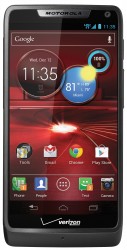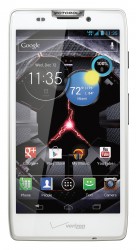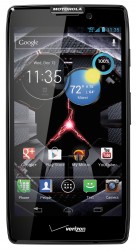Following the Nokia announcement yesterday, across town in the same city, Motorola, Google and Verizon held their own press event in order to announce their latest flagship Android smartphones in the Droid RAZR M, RAZR HD and RAZR MAXX HD.
All three phones are key to Motorola Mobility’s new tack now that the company is directly integrated within Google and is taking advantage of the search giant’s resources. That the new phones are also being placed under both the Droid and RAZR brands also underscores Motorola’s desire to revive and breathe new life into the moribund RAZR branding, which suffered greatly due to product oversaturation and overexposure before being revived last year.
Starting with the Droid RAZR M, the midrange Android smartphone features the first implementation of an edge-to-edge display on a Motorola smartphone, with a 4.3 inch display in the same space as the 3.5 inch displays found on older Motorola Android smartphones. The specifications for the RAZR M also reflect Motorola’s commitment to make high-end devices with the following specifications, with the RAZR HD and MAXX HD being differentiated by battery size:
? 4G LTE
? Interactive Circles Widget allows quick access to notifications, weather, time and more
? Quick Settings can be accessed directly from the home screen so customers can easily manage their volume profile, Wi-Fi, Bluetooth®, GPS and more
? Enhanced Help Guides provide interactive tutorials, help topics and tips to become a DROID RAZR expert
? Global Ready so customers can have voice and data service in more than 205 countries
? Business ready with enterprise grade security and data encryption, remote wipe, complex password support, IPsec multi-headed VPN client and Microsoft Exchange ActiveSync® support
? 1.5 GHz dual-core processor and 1 GB RAM
? Mobile Hotspot – Share a 4G LTE connection with up to eight Wi-Fi-enabled devices
? 8-megapixel camera with LED flash and 1080p HD recording
? Front-facing camera for video chatting
? NFC-enabled so customers can send contacts, links, maps and more directly to compatible phones with Android Beam™
? Corning® Gorilla® Glass display, DuPont™ KEVLAR® fiber and water-repellent nanocoating
? microSD™ card slot with support for up to 32 GB
The new DROID RAZR line will launch with Android™ 4.0 Ice Cream Sandwich and will be upgradeable to Android 4.1 Jelly Bean by end of 2012, with select 2011 models also being upgraded to Jelly Bean. Those models not being upgraded to Jelly Bean will be eligible for a $100 trade-in credit towards the purchase of a new Droid RAZR, the paltry credit amount is cold comfort and could even be considered an insult to customers that are currently in contract and expecting either ICS or Jelly Bean updates for their respective devices only to be left out in the cold and essentially being forced to upgrade early just to keep current.
Also worth noting was Motorola’s newfound commitment to developer editions of Android flagships for developers and enthusiasts, but made no direct mention of the new Droid RAZR series being made available in such a way, other than paying lip service to the idea and makiung references to other devices.
One key addition to the Droid RAZR series is the inclusion of Google Chrome as the default browser on the phones announced, though the announcement was marred by a rather embarrassing botched demo which did not go as planned due to the failure of the local Wi-Fi network during the event itself, and curiously, the 4G LTE network was not used as a backup, leading to more doubts and questions about the browsers actual real-world performance. While the browser is available for download currently, it requires higher than average resources for a browser and is intentionally limited to high-end devices for best performance.
To close out the announcement, more and more are wondering why Motorola would develop and release two nearly identical devices in the RAZR HD and RAZR MAXX HD when both are identical save for battery size, repeating the previous release pattern for the original Droid RAZR and RAZR MAXX. While Motorola and Verizon are touting choice and battery life with both models, the lackluster sales of the original RAZR in comparison to the revised MAXX bear out the preference for battery life over ultimate size, making the RAZR HD essentially redundant.
The RAZR M is currently available for pre-order and will be released next week in all Verizon sales channels for $99.99, while both Verizon and Motorola decided to follow Nokia’s lead in announcing a vague release timeframe for the RAZR HD and MAXX HD for later this year, completely killing any chance for it to build any momentum ahead of the new iPhone’s release later this month and dooming both phones to relative obscurity in comparison.
Had Verizon and Motorola announced that all three phones would be available next week at competitive prices, it would have meant that both companies were actually paying attention and understanding why Apple is able to drive so many sales of its flagship mobile device every year. Alas, it seems that many companies still have lessons to learn when it comes to product launches and announcements.




